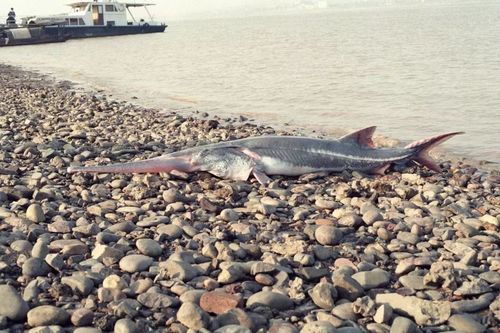
Chinese Paddlefish
The Atlantic Bluefin Tuna (Thunnus thynnus) is a highly migratory, pelagic fish renowned for its size, speed, and commercial value. It plays a crucial role in the marine ecosystem as a top predator. This species faces significant conservation challenges due to its high demand in the global seafood market.
20 50 years
Lifespan
300 - 700 cm
Length
Extinct
Conservation Status
25 km/h
Swimming speed
Carnivorous
Diet
Local Migration
Migration
Appearance Overview
The Atlantic Bluefin Tuna exhibits a robust, streamlined body, perfectly adapted for speed and endurance in the water.
Color
Dark metallic blue on top with a silvery underside, providing effective camouflage
Fins
Two dorsal fins, the first depressible into a groove; a series of small, yellow finlets running from the second dorsal fin and the anal fin to the tail
Body Shape
Torpedo-shaped, designed for efficient movement through water
Length
Up to 13 feet (4 meters), commonly around 6.5 feet (2 meters)
Weight
Up to 2,000 lbs (900 kg), commonly around 550 lbs (250 kg)
Diet
Carnivorous, feeding on a variety of fish, squid, crustaceans, and occasionally, zooplankton and eel.
Feeding Behavior
An opportunistic predator, the Bluefin Tuna uses its exceptional speed and agility to hunt. It often participates in coordinated feeding, herding prey or striking from below.
Social Behavior
Highly migratory, forming large schools, especially during spawning. Schooling behavior varies with age; younger tuna tend to form larger, more homogenous groups.
Commercial Relevance
Extremely high value, particularly in the sushi and sashimi markets, where its fatty flesh is considered a delicacy. This demand drives significant fishing pressure.
Conservation measures
Subject to international fishing quotas, stock assessments, and management plans aimed at rebuilding populations. Marine Protected Areas and fishing gear restrictions are also in place.
Status
Endangered (Varies by population segment; some stocks are more depleted than others)
Threats
Overfishing (primarily driven by demand for sushi), bycatch in other fisheries, climate change affecting prey distribution and spawning habitats, and illegal fishing.
Habitat Distribution
Depth Range
Surface waters to depths of over 3,000 feet (1,000 meters), depending on the season and feeding habits.
Geographic Range
Widely distributed across the Atlantic Ocean, from Newfoundland to the Mediterranean Sea, and into the Gulf of Mexico.
Preferred Environment
Primarily pelagic, inhabiting temperate and subtropical waters; undertakes long migrations across ocean basins.
Reproduction and Life Cycle
Breeding Habits
Spawns in specific areas, notably the Mediterranean Sea and the Gulf of Mexico, with spawning occurring in warm waters during spring and summer.
Development Stages
Eggs are pelagic, floating freely in the water column. Larvae develop rapidly, feeding on plankton and growing into juveniles that resemble miniature adults.
Fecundity
Highly fecund; a single female can produce up to 30 million eggs per spawning season, although survival rates to adulthood are low.
Maturity Age
Reaches sexual maturity at around 4-8 years in the Mediterranean and 8-12 years in the western Atlantic.
Faqs about Chinese Paddlefish
Can you eat Bluefin Tuna?
Yes, but due to its endangered status, consumption is discouraged. If consumed, it should be sourced from sustainably managed fisheries.
How long does a Bluefin Tuna live?
Bluefin Tuna can live up to 40 years, though the average lifespan is shorter due to fishing pressure.
Are Bluefin Tuna warm-blooded?
Yes, Bluefin Tuna are warm-blooded, unlike most fish. They have a unique circulatory system that allows them to maintain a body temperature higher than the surrounding water.
How fast is the Bluefin Tuna?
Bluefin tuna are among the fastest fish in the ocean. They are built for speed, with a streamlined body and powerful muscles and can reach speeds up to 43 mph (70 km/h).
How many bluefin tuna are left in the world?
The population of bluefin tuna is difficult to assess with certainty. However, it is well documented that there has been an extreme decline in the fish stock since the 1970's.
Copyright @ Nature Style Limited. All Rights Reserved.
 English
English